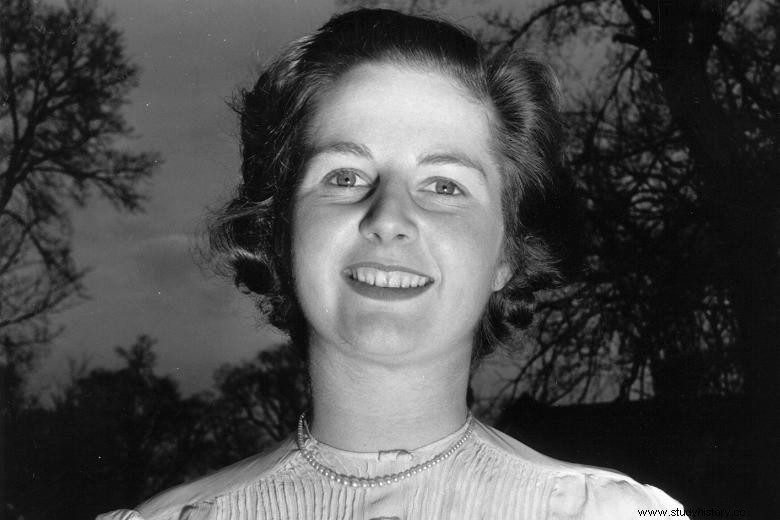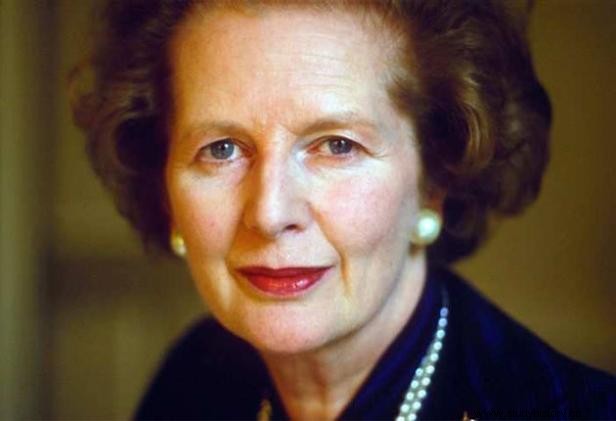Margaret Hilda Thatcher (1925 – 2013) was a British stateswoman. A very controversial political figure, she is the first and only female Prime Minister of the United Kingdom and leader of the Conservative Party.
Chemistry studies
 Daughter of Beatrice and Alfred Roberts, seamstress and grocer respectively, Margaret Roberts was born on October 13, 1925 in Grantham, England, in a rather modest environment. His rigorous upbringing is marked by the Methodist faith and the conservatism of his parents. She discovers politics early through the commitments of her father who will be mayor of Grantham for a few years.
Daughter of Beatrice and Alfred Roberts, seamstress and grocer respectively, Margaret Roberts was born on October 13, 1925 in Grantham, England, in a rather modest environment. His rigorous upbringing is marked by the Methodist faith and the conservatism of his parents. She discovers politics early through the commitments of her father who will be mayor of Grantham for a few years.
Margaret spends the first part of the Second World War in Grantham which is bombed. In 1943, she went to Oxford to study chemistry. At university, she became president of the association of conservative students (OUCA); during her presidency, the number of student members of OUCA grew from 400 to more than 1,000. She earned a bachelor's degree in chemistry and worked in research between 1947 and 1951.
First responsibilities
In 1950, the youngest woman candidate in the country, she tried to be elected as a deputy in a constituency lost in advance that the party had entrusted to her; she fails but reduces her opponent's lead by 6,000 votes. She then devotes her evenings and weekends to law studies. In 1951, she married Denis Thatcher with whom she had twins in 1953. In 1954, she became a lawyer. In 1959, she was elected to Parliament in the constituency of Finchley (north of London) and entered the House of Commons, where she was re-elected until 1992. She was quickly noticed for her talents as a speaker.
From 1964 to 1970, she served as spokesperson for her party in the House of Commons. As a member of parliament, she takes a position in favor of the decriminalization of male homosexuality and the legalization of abortion, but against the abolition of the death penalty and the relaxation of divorce. In 1967, she was entrusted with the Ministry of Energy, then that of Transport in 1968 and of National Education a few months later.
In 1970, she was appointed Minister of Education and Science. Having to cut ministry expenses, in 1971 it abolished free milk distribution for children aged seven to eleven, attracting numerous protests. It establishes compulsory education up to the age of 16, increases the number of crèches and launches a major program to renovate primary schools.
Rising to power
 In 1974, the conservatives lost the elections but she was re-elected and found herself, in 1975, at the head of the opposition by obtaining the post of leader of the Conservative Party. She takes a strong stance against communism, accusing the Soviets of striving for world domination, and earns her nickname "Iron Lady" by the Soviet Ministry of Defense newspaper, The Red Star . She travels to many countries to meet leaders and gain international stature. During this time, the Labor government encountered great difficulties and Margaret Thatcher took the opportunity to attack the unions. During the winter of 1978-1979, strikes paralyzed the country and, on March 28, 1979, the Labor government was overthrown by a motion of censure. In May, during the election, Margaret leads the Conservative Party to victory. On May 4, 1979, becoming Prime Minister of the United Kingdom, she became the first woman to lead the government of a Western country.
In 1974, the conservatives lost the elections but she was re-elected and found herself, in 1975, at the head of the opposition by obtaining the post of leader of the Conservative Party. She takes a strong stance against communism, accusing the Soviets of striving for world domination, and earns her nickname "Iron Lady" by the Soviet Ministry of Defense newspaper, The Red Star . She travels to many countries to meet leaders and gain international stature. During this time, the Labor government encountered great difficulties and Margaret Thatcher took the opportunity to attack the unions. During the winter of 1978-1979, strikes paralyzed the country and, on March 28, 1979, the Labor government was overthrown by a motion of censure. In May, during the election, Margaret leads the Conservative Party to victory. On May 4, 1979, becoming Prime Minister of the United Kingdom, she became the first woman to lead the government of a Western country.
She quickly launched her first reforms, drastically reducing public spending, launching a program of privatizations and attacking the powers of the unions. Re-elected in 1984, she continued her policy marked by political conservatism, economic liberalism and social traditionalism.
Foreign policy
At the start of his mandate, the Irish situation deteriorated. In 1980, IRA prisoners began a hunger strike to demand the status of political prisoners, followed by a second in 1981. Ten strikers died and Margaret Thatcher proved inflexible. The same year, she met the Irish President and strengthened cooperation between the two countries. In 1984, an IRA bombing nearly killed Margaret Thatcher and several members of the government. On this occasion, she shows a remarkable coolness.
In 1982, Argentina attacked the Falkland Islands and South Georgia, British archipelagos, and Margaret Thatcher immediately decided to reconquer them by force, supported by Pinochet's Chile - which would later cause controversy. Her inflexibility in this conflict reinforces her reputation and her nickname of "Iron Lady". She opposes harsh sanctions against the South African regime which practices apartheid, deeming them dangerous for the stability of the region because they could cause anarchy. A Eurosceptic, she opposes the idea of a federal Europe and strengthens her ties with the United States.
The fall
In 1990, Margaret Thatcher introduced a new local tax, the poll tax, so unpopular that it led to riots. This will be the beginning of his downfall. She found herself in the minority in her own party and, in 1990, former defense minister Michael Heseltine ran for leader of the Conservative Party and won enough votes to put the prime minister on the ballot. Margaret Thatcher announces that she refuses to submit to a second round and that she resigns. After resigning, she was made a Peer of the United Kingdom in 1992. In 2002, on the advice of her doctors, she retired from public life.
Margaret Thatcher died on April 8, 2013 of a stroke.
